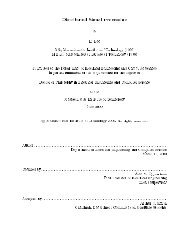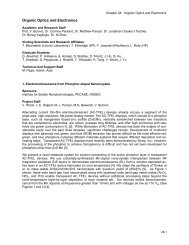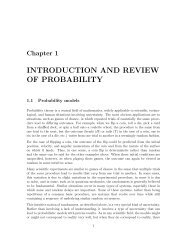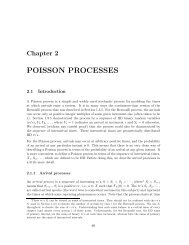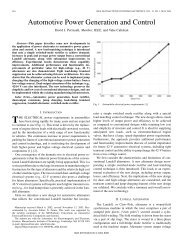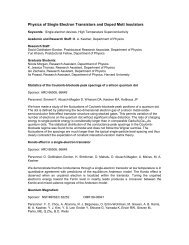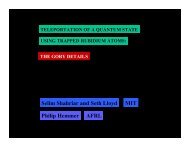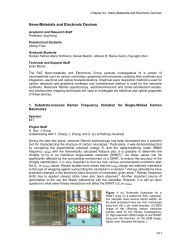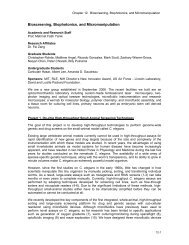electromagnetic wave theory and applications - Research ...
electromagnetic wave theory and applications - Research ...
electromagnetic wave theory and applications - Research ...
Create successful ePaper yourself
Turn your PDF publications into a flip-book with our unique Google optimized e-Paper software.
ELECTROMAGNETIC WAVE THEORY AND APPLICATIONS<br />
Academic <strong>and</strong> <strong>Research</strong> Staff<br />
Professor Jin Au Kong, Dr. Yan Zhang, Dr. Robert T. Shin, Dr. Fern<strong>and</strong>o L. Teixeira,<br />
Dr. Y. Eric Yang<br />
Visiting Scientists <strong>and</strong> <strong>Research</strong> Affiliates<br />
Dr. Arthur K. Jordan, U.S. Navy, Naval <strong>Research</strong> Laboratory, Washington, DC.<br />
Dr. Kevin O'Neill, U.S. Army, Cold Regions <strong>Research</strong> <strong>and</strong> Engineering Laboratory, Hanover,<br />
New Hampshire.<br />
Dr. Michael Tsuk, Digital Equipment Corporation, Tewksbury, Massachusetts.<br />
Dr. Akira Itoh, Tokyo National University of Science <strong>and</strong> Technology, Tokyo, Japan.<br />
Dr. Yih-Min Chen, Yuan-Tze University, Chung-Li, Taiwan.<br />
Dr. Chien-Chin Chiu, Tam-Kang University, Tam-Shui, Taiwan.<br />
Dr. Leung Tsang, University of Washington, Seattle, Washington.<br />
Dr. Tarek M. Habashy, Schlumberger-Doll <strong>Research</strong>, Ridgefield, Connecticut.<br />
Dr. Tomasz Grzegorczyk, Swiss Federal Institute of Technology, Lausanne.<br />
Graduate Students<br />
Henning Braunisch, Chi On Ao, Bae-Ian Wu, Christopher Moss, Benjamin E. Barrowes,<br />
Joe Pacheco, Siwaphong Boonsalee, Kenroy R. Cayetano<br />
Technical <strong>and</strong> Support Staff<br />
Zhen Wu, Bin Hu, Wen-Ling Hsiao, Lan Benarieb<br />
<strong>Research</strong> on SAR Simulation Model<br />
Sponsor<br />
Mitsubishi Corporation<br />
Project Staff<br />
Professor Jin Au Kong, Dr. Yan Zhang<br />
Joe Pacheco, Bae-Ian Wu<br />
In this work, we develop an image processing scheme to generate synthetic aperture radar (SAR)<br />
images from a rough surface terrain, which is specified by a digital elevation map (DEM), with large<br />
dihedral reflectors (e.g. tree trunks). Important in the analysis of such SAR systems is a knowledge<br />
of the <strong>electromagnetic</strong> characteristics of the target being studied. In order to determine the<br />
<strong>electromagnetic</strong> characteristics of the region being analyzed, the rough surface <strong>and</strong> dihedral<br />
reflectors are modeled as a collection of triangular facets. The backscattering response is then<br />
obtained using the Physical Optics (PO) method. A closed form solution to the PO integral for flat<br />
polygonal plates is used to quickly calculate the response from each facet. Although the PO method<br />
is based on high-frequency approximations, it is found, based on comparisons with exact MoM<br />
results, to be a valid approach for relatively smooth surfaces where the correlation length is<br />
greater than a few <strong>wave</strong>lengths. To accurately model the dihedral reflectors a double bounce<br />
model based on the scattering matrix formalism is used to include the contribution of the interaction<br />
between the rough surface <strong>and</strong> the dihedral reflector.<br />
The SAR image is then obtained by using a matched-filter approach which incorporates both range<br />
<strong>and</strong> cross-range focusing. In comparison with frequency-domain, or Doppler based algorithms, the<br />
matched filter approach allows for simple <strong>and</strong> accurate SAR signal processing of b<strong>and</strong>-limited<br />
signals. The matched filter approach works by correlating the received signal with a reference
signal, which is defined to be the response from a point scatterer at a given position along the<br />
ground. Regions of high correlation correspond to the locations of the scatterers with strong<br />
backscattering responses. This correlation process can be performed in either the time or spectral<br />
domains, the two approaches are equivalent. In this work, the spectral domain representation is<br />
used since the scattering coefficients are calculated as a function of frequency.<br />
The model for the received signal that the SAR receives is determined by convolving the scattering<br />
response with the incident pulse shape, which is assumed to be a b<strong>and</strong>-limited chirp signal<br />
multiplied by a Gaussian footprint function. Previous work included the development of an efficient<br />
SAR image simulation scheme for non-dispersive scatterers, which allowed the correlation integral<br />
to expressed in a closed form solution yielding a highly efficient algorithm. However, in this work<br />
we allow for the presence of dispersive scatterers while maintaining computational efficiency. This<br />
is accomplished by evaluating the range focusing aspect of the matched filter correlation integral<br />
using a linear interpolation scheme in which the fast varying part of the received signal is<br />
accounted for analytically. This in turn allows the cross-range focusing sum to be computed<br />
analytically in closed form. The resulting efficient algorithm allows for the modeling of large terrains.<br />
Several test cases have been modeled such as rough surfaces with tree structures, <strong>and</strong> flat<br />
surfaces with building <strong>and</strong> ditch structures.<br />
Wideb<strong>and</strong> Antenna Element<br />
Sponsor<br />
Mitsubishi Corporation<br />
Project Staff<br />
Professor Jin Au Kong, Dr. Yan Zhang<br />
Bae-Ian Wu, Joe Pacheco<br />
Several kinds of antenna elements, including fractal antennas, bow-tie antennas, spiral antennas<br />
<strong>and</strong> log-periodic antennas, are investigated. The theoretical limit on the b<strong>and</strong>width of an electrically<br />
small antenna is used as a guideline for comparing the b<strong>and</strong>width performance against the<br />
normalized size of the antenna. The properties of ultra-wideb<strong>and</strong> (UWB) performance, with a<br />
fractional b<strong>and</strong>width greater than 100% is attributed to the complementary <strong>and</strong> self-similar structure<br />
of the antenna elements.<br />
Smart skin antennas were originally designed by utilizing the surfaces of a moving vehicle, such as<br />
an airplane, to establish an advanced antenna system for communication <strong>and</strong>/or remote sensing.<br />
As a result, the smart skin antenna achieves many-fold increases in communication range, reduces<br />
the size <strong>and</strong> weight of the hardware <strong>and</strong> aerodynamic drag, <strong>and</strong> simplifies the maintenance of the<br />
electronics. Recently, interests have been focused on extending <strong>and</strong> improving the performance of<br />
the smart skin antenna. For instance, to use the same geometrical design to operate on several<br />
radio frequencies simultaneously or selectively, <strong>and</strong> to form scanning beams with low-level<br />
sidelobes. As a large b<strong>and</strong>width of the operation frequency is required, an ultra-wideb<strong>and</strong> antenna<br />
element is needed. The UWB antennas have the properties of maintaining a good impedance<br />
matching <strong>and</strong> radiation pattern over a wide frequency range. In particular, the impedance matching<br />
is often required such that the return loss is less than 10 dB at the input port of the antenna.<br />
For instance, to achieve an UWB response from an antenna element, frequency independence<br />
based on the principles of self-similarity <strong>and</strong> self-complementary can be used. Fractal, bow-tie,<br />
spiral <strong>and</strong> log-periodic can all reach b<strong>and</strong>widths in excess of 1:4 provided that the electrical size is<br />
reasonably large. With the exception of the log-periodic antenna where the total array size is<br />
relatively large, fractal, bow-tie <strong>and</strong> spiral antennas have a characteristic length approximately<br />
equal to the <strong>wave</strong>length of the central frequency. The different implementations of these antennas
are compared by plotting the inverse of the b<strong>and</strong>width versus the normalized size of the antenna.<br />
They are found to follow a trend that is parallel to the inverse of the limiting half power b<strong>and</strong>width.<br />
In general, a log-periodic antenna has a good polarization <strong>and</strong> b<strong>and</strong>width performance; however, it<br />
also has a large overall size that compromises its performance. The spiral antenna, despite the fact<br />
that it can only have circular polarization, is very compact <strong>and</strong> has been extensively studied. The<br />
advancement in tapering the current in the spiral arms by various means extends the b<strong>and</strong>width<br />
attainable by the spiral elements. Like the spiral antenna, the bow-tie antenna also has a compact<br />
size, a wide b<strong>and</strong>width, <strong>and</strong> a simple structure, but it produces linear polarization. The Sierpinski<br />
Gasket monopole antenna achieves good b<strong>and</strong>width with tuning <strong>and</strong> stacking; however, recent<br />
implementations are not conformal in the sense that the antenna is perpendicular to the ground<br />
plane. Also, while non-fractal wideb<strong>and</strong> antennas may utilize complementary structures to achieve<br />
continuous wideb<strong>and</strong> impedance matching, the multib<strong>and</strong> behavior of the fractal antenna is very<br />
distinct <strong>and</strong> may offer a better return loss for each particular b<strong>and</strong>. The use of transmission line<br />
models correctly explain the position of multib<strong>and</strong> through the adjustment of the attenuation<br />
parameters.<br />
Evaluation of SAR Interferometry using Wavelet Denoising<br />
Sponsor<br />
Mitsubishi Corporation<br />
Project Staff<br />
Professor Jin Au Kong, Dr. Yan Zhang<br />
Bae-Ian Wu, Joe Pacheco<br />
Obtaining a digital elevation model (DEM) with the help of synthetic aperture radar (SAR)<br />
interferometry requires 2-D phase unwrapping known to be sensitive to noise. In particular, the<br />
existence of local inconsistencies of the data, referred to as residues, slows down the<br />
convergence of typical unwrapping algorithms <strong>and</strong> introduces inaccuracies into the height<br />
inversion. To reduce the effect of noise, some sort of preprocessing of the interferogram is<br />
desired. This suggests applying the computationally efficient Donoho <strong>wave</strong>let denoising technique,<br />
with the complex interferogram as input, that preserves the lines of phase discontinuity (fringes)<br />
yielding filtered images of good visual quality. We evaluate the height retrieval accuracies of this<br />
algorithm using simulated SAR data, <strong>and</strong> real SAR data (Mt. Fuji) from JERS-1.<br />
For a simulated Gaussian mountain, the improvement of the unwrapping accuracies is very distinct,<br />
from 3% to 1% rms error. The height inversion of the simulated SAR interferogram based on the<br />
Grayling data shows that, with preprocessing, the height inversion is less susceptible to noise<br />
corruption. For the Mt. Fuji data, assumption of the system parameters have been made <strong>and</strong> the<br />
error figure on the 512 by 512 interferogram is 118 m of rms height (st<strong>and</strong>ard deviation). More<br />
accurate system data is needed to aid the inversion for further comparison of different unwrapping<br />
schemes used in combination with the preprocessing technique.<br />
On the development of unwrapping algorithms, regular least square method fails to take into<br />
account that the rewrapped image of the unwrapped phase differs from the original interferogram,<br />
<strong>and</strong> can be improved by using that difference in the iteration. A preliminary study shows that the<br />
convergence rate improves with the new method. Convergence is reached for a preset residue<br />
level of 10 -3 in 17 iterations instead of 28 iterations. By taking into account the difference between<br />
the rewrapped image of the unwrapped phase differences <strong>and</strong> the original interferogram, the<br />
solution yields a higher DEM which compensates for the underestimation of the least square<br />
method.
Polarimetric Passive Remote Sensing<br />
Sponsor<br />
Office of Naval <strong>Research</strong><br />
Project Staff<br />
Professor Jin Au Kong, Dr. Y. Eric Yang, Dr. Yan Zhang, Dr. Tomasz Grzegorczyk<br />
Chi O. Ao, Bae-Ian Wu<br />
Recently there has been significant interest in using polarimetric passive remote sensing<br />
measurements from wind-roughened ocean surfaces to deduce wind vector information.<br />
However, the presence of foam on the ocean surface complicates such analyses. Even though<br />
only a small portion of the sea surface is covered with foam, the foam has a very high emissivity<br />
compared with open sea surface <strong>and</strong> must be accounted for correctly.<br />
We model the foam as a layer of densely packed air bubbles. Each bubble is taken to be spherical<br />
with a thin outer layer of sea water. Because the bubbles are packed closely together, coherent<br />
multiple scattering effects must be properly included. Thus we use the <strong>theory</strong> of quasi-crystalline<br />
approximation (QCA) to compute the collective scattering response from the foam particles. The<br />
QCA allows us to incorporate the correlation property of the particle positions <strong>and</strong> its effects on<br />
multiple scattering. In contrast to the traditional dense medium approach which assumes small<br />
particles, we formulate QCA using the T-matrix coefficients that are applicable to particles of<br />
general sizes. The extinction coefficient <strong>and</strong> scattering phase matrix obtained using QCA are then<br />
used as inputs to the dense medium radiative transfer (DMRT) equation. The polarimetric brightness<br />
temperatures from a foam-covered ocean surface are obtained by solving the DMRT equation with<br />
appropriate boundary conditions. Our model provides a rigorous basis to relate bubble<br />
characteristics to foam emission that is applicable for any bubble size <strong>and</strong> concentration.<br />
Computational Method in Multiple Scattering by Spheroidal Scatterers<br />
Sponsor<br />
Office of Naval <strong>Research</strong><br />
Project Staff<br />
Professor Jin Au Kong, Dr. Yan Zhang<br />
Benjamin E. Barrowes, Chi O. Ao<br />
The Sparse Matrix/Canonical Grid (SMCG) method is applied to 3-D r<strong>and</strong>om media scattering<br />
simulations. The r<strong>and</strong>om medium consists of r<strong>and</strong>omly positioned <strong>and</strong> oriented discrete dielectric<br />
spheroids contained in a cubic test volume. The SMCG method reduces the complexity for each<br />
matrix-vector multiply an iterative solver normally requires from O(N 2 ) to O(N log N). Interactions are<br />
decomposed into “strong” <strong>and</strong> “weak” interactions by defining a neighborhood distance (specified<br />
in terms of gridpoints). Strong interaction terms are calculated directly with no approximation<br />
requiring O(N) complexity for each iteration. Weak interaction terms are approximated by a<br />
multivariate Taylor series expansion around the nearest gridpoint to gridpoint distance for any given<br />
pair of particles. The multilevel block Toeplitz (MBT) structure inherent in weak interaction matrices<br />
allows a 1-D FFT of complexity O(N log N) to replace the dense matrix-vector multiply in the iterative<br />
solver. Greater accuracy may be achieved by increasing the neighborhood distance, a higher order<br />
expansion, <strong>and</strong>/or a finer grid at the cost of more interaction terms, more FFTs, <strong>and</strong>/or longer FFTs,<br />
respectively. Results indicate that the SMCG method achieves a substantial reduction in<br />
computational complexity compared to the st<strong>and</strong>ard full method.
A new method to realize matrix-vector multiplies involving Multilevel Block Toeplitz (MBT) matrices<br />
occurring in 3-D <strong>electromagnetic</strong> scattering was developed. This method extracts only the unique<br />
terms from the MBT matrix into an auxiliary vector, thus reducing computer memory requirements.<br />
The matrix-vector multiply is then realized as a convolution, or equivalently as an outer product in<br />
the Fourier domain, requiring only O(N log N) complexity. Implementation into the SMCG method<br />
showed a substantial speedup when compared to the full dense method.<br />
Electromagnetic Models <strong>and</strong> Data Analysis for UXO Discrimination<br />
Sponsor<br />
Cold Regions <strong>Research</strong> <strong>and</strong> Engineering Laboratory<br />
Project Staff<br />
Professor Jin Au Kong, Dr. Leung Tsang<br />
Chi O. Ao, Henning Braunisch<br />
Broadb<strong>and</strong> <strong>electromagnetic</strong> induction (EMI) sensors are promising in the detection <strong>and</strong><br />
discrimination of subsurface unexploded ordnance (UXO). However, theoretical modeling of E M I<br />
responses from nonspherical objects has been lacking. In this work, we obtain the quasimagnetostatic<br />
solutions for conducting <strong>and</strong> permeable spheroids under arbitrary primary field<br />
excitation. The problem is solved analytically using the separation of variables method in spheroidal<br />
coordinates. In this method, the interior magnetic field is exp<strong>and</strong>ed in terms of vector spheroidal<br />
<strong>wave</strong>functions. On the other h<strong>and</strong>, because the medium surrounding the spheroid is poorly<br />
conducting, we can exp<strong>and</strong> the exterior magnetic field simply in terms of the magnetostatic<br />
(Laplace) solutions. The unknown expansion coefficients are solved by imposing the appropriate<br />
boundary conditions at the surface of the spheroid. This formulation is exact; however, the<br />
solutions break down at high frequencies due to numerical problems in the computation of the<br />
spheroidal <strong>wave</strong>functions. Since a broadb<strong>and</strong> response is desired, we also develop an<br />
approximate <strong>theory</strong> known as the small penetration-depth approximation (SPA). The SPA is based<br />
on the observation that at high frequencies, the primary field decays rapidly as it penetrates the<br />
spheroid. This allows us to reformulate the system equations in terms of the exterior fields only <strong>and</strong><br />
circumvents the numerical difficulty associated with the spheroidal <strong>wave</strong>functions.<br />
Even though the SPA is motivated by the high frequency behavior of the interior magnetic field, w e<br />
find that the method is in fact capable of yielding accurate results over all frequencies for highly<br />
permeable spheroids. This case is of practical significance because many UXO have high<br />
permeability material components (e.g., steel). For such objects, SPA gives us a computationally<br />
efficient method for calculating their broadb<strong>and</strong> EMI responses, without any limitation in terms of<br />
frequency <strong>and</strong> aspect ratio. The corresponding numerical code is therefore ideally suited as<br />
forward model in a systematic inversion for some of the parameters of a given configuration. Even<br />
though our investigations focus on spheroids only, it should be noted that prolate <strong>and</strong> oblate<br />
spheroids provide a very general <strong>and</strong> versatile model for nonspherical geometry that ranges from<br />
long needle to sphere to flat disc.<br />
Since multiple UXO as well as substantial amount of debris are likely to be located in the same area,<br />
we also calculate the broadb<strong>and</strong> EMI response from multiple objects. Preliminary study shows that<br />
mutual interactions are generally negligible. We investigate the effects of orientation averaging as<br />
well as multiple sizes on the broadb<strong>and</strong> EMI response. It is found that responses from individual<br />
objects could overlap <strong>and</strong> make target discrimination more difficult.
Finite Difference Techniques for Body of Revolution Radar Cross Section<br />
Sponsor<br />
MIT Lincoln Laboratory<br />
Project Staff<br />
Professor Jin Au Kong, Dr. Y. Eric Yang, Dr. Robert G. Atkins<br />
Joe Pacheco<br />
A number of radar cross section prediction techniques have been developed which exploit body of<br />
revolution (BOR) symmetry, reducing computational requirements <strong>and</strong> enabling calculations for<br />
electrically larger objects. These approaches include both frequency domain Method of Moments<br />
(MoM) BOR algorithms, <strong>and</strong> more recently, Finite-Difference Time-Domain (FDTD) BOR<br />
implementations. In cases where the signature is desired over an extended b<strong>and</strong>width, FDTD BOR<br />
techniques have the advantage of calculating the entire frequency extent simultaneously.<br />
However, the FDTD simulation still must be repeated for each incident angle of interest, <strong>and</strong> as the<br />
target size becomes large, <strong>and</strong> wideb<strong>and</strong> signatures become necessary at many incident<br />
directions, additional reductions in computation are desirable. The purpose of this work is to<br />
examine three finite-difference approaches to determine their accuracy <strong>and</strong> potential for further<br />
relaxing computational requirements for particular body of revolution geometries.<br />
The first approach reduces the overall computational burden by lowering the number of angles at<br />
which calculations must be performed. A single FDTD BOR simulation is used to calculate the<br />
monostatic signature for one incident angle, as well as bistatic signatures for adjacent observation<br />
directions. The bistatic equivalence theorem is then used to approximate monostatic signatures for<br />
other angles near the incident direction of the actual FDTD BOR simulation. In contrast, the second<br />
approach reduces computational requirements for BOR objects of large electrical radius, using a<br />
hybrid FDTD <strong>and</strong> Geometrical Optics formulation. Individual scattering centers such as surface<br />
gaps, protrusions, or slope discontinuities are identified, <strong>and</strong> integral expressions derived for the<br />
scattering of each. These expressions are evaluated by the method of stationary phase, in which<br />
the contribution is assumed to arise from a stationary phase point in the plane of incidence. A twodimensional<br />
scattering problem is created by a local tangent plane approximation through the<br />
stationary phase point, <strong>and</strong> this is solved via a two-dimensional FDTD approach. Finally, the third<br />
approach reduces computer memory requirements by simplifying the finite difference equations<br />
used in the solution. Explicit phase dependence is introduced for propagation of the incident <strong>wave</strong><br />
over the BOR object, producing a parabolic <strong>wave</strong> equation (PWE). As with the BOR FDTD<br />
approach, symmetry is exploited to decouple the three-dimensional PWE problem into a sequence of<br />
two-dimensional problems, which are solved by an efficient marching in space approach. For each<br />
of these results are compared with st<strong>and</strong>ard FDTD <strong>and</strong> MoM BOR approaches, high frequency<br />
physical <strong>theory</strong> of diffraction approximations, <strong>and</strong> measurements or Analytical results where<br />
available. From these comparisons, the accuracy <strong>and</strong> computational requirement tradeoffs possible<br />
with this collection of finite-difference signature tools are determined.<br />
Inverse Scattering Models for Recognition of Targets in R<strong>and</strong>om Media<br />
Sponsor<br />
MIT Lincoln Laboratory<br />
Project Staff<br />
Professor Jin Au Kong, Dr. Y. Eric Yang<br />
Christopher Moss<br />
A Three-dimensional FDTD simulation is used to compute the scattered field of an object in or<br />
beneath a r<strong>and</strong>om medium. The FDTD computational domain contains three layers: free-space, <strong>and</strong>
two layers of r<strong>and</strong>om media that may also contain an object. The r<strong>and</strong>om media can be used to<br />
describe many types of physical media, such as snow, soil, or vegetation. Here we use them to<br />
model soil, with ground penetrating radar <strong>applications</strong> in mind. The soil is modeled as a r<strong>and</strong>om<br />
permittivity that fluctuates from cell to cell, described by a correlation function that is Gaussian in<br />
the horizontal direction <strong>and</strong> exponential in the vertical direction. Parameters such as the mean <strong>and</strong><br />
variance of the soil permittivity are determined by experimental data. Both the homogeneous <strong>and</strong> the<br />
r<strong>and</strong>om layers are lossy, so a modified PML with stretched coordinates is used to terminate the<br />
computational domain. The simulation assumes a TE or TM plane <strong>wave</strong> incidence, <strong>and</strong> uses a total<br />
scattered field formulation for stratified media. The near to far field transformation is performed by<br />
enclosing both the object <strong>and</strong> r<strong>and</strong>om media in a Huygens’ surface, <strong>and</strong> integrating the equivalent<br />
frequency domain electric <strong>and</strong> magnetic currents with the layered Green's function. The targets<br />
modeled are metal <strong>and</strong> dielectric cylinders, created with a conformal mapping technique. Our<br />
interest lies in cases where the scattered fields of the target are much smaller than the clutter of<br />
the r<strong>and</strong>om medium. Monte-Carlo analysis is performed using an ensemble of r<strong>and</strong>om media whose<br />
parameters appropriately model various soil types. Each realization of the r<strong>and</strong>om medium is<br />
generated in the spectral domain by filtering r<strong>and</strong>om numbers (with zero mean <strong>and</strong> normalized<br />
variance) with the Fourier transform of the correlation function. A three dimensional Fast Fourier<br />
Transform is then used to generate the spatial fluctuation, which is mapped into the FDTD<br />
computational domain. The statistical properties of the scattered field are studied using the<br />
numerical simulation technique described above. In addition to Monte-Carlo analysis, frequency<br />
averaged radar cross section <strong>and</strong> the Angular Correlation Function are applied to determine their<br />
effectiveness in detecting the object.<br />
X-B<strong>and</strong> Radar Propagation over Mountainous Terrain<br />
Sponsor<br />
MIT Lincoln Laboratory<br />
Project Staff<br />
Professor Jin Au Kong, Dr. Hsiu Han, Dr. Yan Zhang, Dr. Tomasz Grzegorczyk<br />
Christopher Moss<br />
In this project, we are concerned with accurately modeling the effects of terrain on the<br />
performance of X-b<strong>and</strong> ground based radar. The type of terrain in question is extremely large, both<br />
in distance (typically 50 km) <strong>and</strong> height variation (up to 500 m), although we limit the scale of the<br />
local roughness to no less than a few <strong>wave</strong>lengths. To fully account for all surface scattering<br />
phenomena, we use an integral equation formulation which leads to an exact solution of the<br />
<strong>electromagnetic</strong> problem. Due to this terrain size, the exact formulation requires a prohibitively large<br />
number of unknowns, so we incorporate a Fast Multipole Method to make the problem tractable. We<br />
also use basis functions that are optimal for given surface profiles, such as <strong>wave</strong>lets for areas<br />
with local roughness <strong>and</strong> Natural Basis set for smoother portions of the terrain. These fast<br />
techniques result in huge reductions of memory requirements <strong>and</strong> computational cost, although their<br />
efficiency decreases as the surface roughness increases. Furthermore, we include a layer of<br />
r<strong>and</strong>om medium on the terrain to incorporate the effects of foliage (although it could be another<br />
geophysical medium, such as snow). The r<strong>and</strong>om medium is created using Strong Fluctuation<br />
Theory to model the discrete scatterers (leaves) in the foliage, obtaining values for the mean<br />
(effective) <strong>and</strong> variance of the permittivity. Ultimately we will add a target to the simulation, placed<br />
up to 50 km from the source, to study the complete radar system performance for given terrain<br />
profiles.
PUBLICATIONS<br />
Books<br />
Progress in Electromagnetics <strong>Research</strong> (J. A. Kong, ed.), PIER 25, EMW Publishing, Cambridge,<br />
Massachusetts, 2000.<br />
Progress in Electromagnetics <strong>Research</strong> (J. A. Kong, ed.), PIER 26, EMW Publishing, Cambridge,<br />
Massachusetts, 2000.<br />
Progress in Electromagnetics <strong>Research</strong> (J. A. Kong, ed.), PIER 27, EMW Publishing, Cambridge,<br />
Massachusetts, 2000.<br />
Progress in Electromagnetics <strong>Research</strong> (J. A. Kong, ed.), PIER 28, EMW Publishing, Cambridge,<br />
Massachusetts, 2000.<br />
Progress in Electromagnetics <strong>Research</strong> (J. A. Kong, ed.), PIER 29, EMW Publishing, Cambridge,<br />
Massachusetts, 2000.<br />
Scattering of Electromagnetic Waves: Theories <strong>and</strong> Applications (L. Tsang, J. A. Kong, <strong>and</strong> K. H.<br />
Ding), Wiley-Interscience, New York, 2000.<br />
Journal Papers<br />
J. J. Akerson, Y.-C. E. Yang, Y. Hara, B.-I. Wu, <strong>and</strong> J. A. Kong, "Automatic phase unwrapping<br />
algorithm in synthetic aperture (SAR) interferometry" IEICE Trans., vol. E83-C, no. 12, pp.<br />
1896–1904, Dec. 2000.<br />
B. E. Barrowes, C. O. Ao, F. L. Teixeira, J. A. Kong, <strong>and</strong> L. Tsang, "Monte Carlo simulation of<br />
<strong>electromagnetic</strong> <strong>wave</strong> propagation in dense r<strong>and</strong>om media with dielectric spheroids", IEICE<br />
Trans., vol. E83-C, no. 12, pp. 1797–1802, Dec. 2000.<br />
H. Braunisch, Y. Zhang, C. O. Ao, S. E. Shih, Y. E. Yang, K. H. Ding, J. A. Kong, <strong>and</strong> L. Tsang,<br />
“Tapered <strong>wave</strong> with dominant polarization state for all angles of incidence,” IEEE Trans.<br />
Antennas Propagat., vol. 48, no. 7, pp. 1086–1096, July 2000.<br />
L. W. Li, D. You, M. S. Leong, T. S. Yeo, <strong>and</strong> J. A. Kong, “Electromagnetic scattering by<br />
multilayered chiral-media structures: a scattering-to-radiation transform,” J. Electromagn.<br />
Waves Appl., vol. 14, pp. 401–403, 2000.<br />
L. W. Li, S. N. Lim, M. S. Leong, <strong>and</strong> J. A. Kong, “Vector <strong>wave</strong> function expansion for dyadic<br />
Green's functions for cylindrical chiro<strong>wave</strong>guides: an alternative representation,” J.<br />
Electromagn. Waves Appl., vol. 14, pp. 673–692, 2000.<br />
J. A. Oswald, B.-I. Wu, K. A. McIntosh, L. J. Mahoney, <strong>and</strong> S. Verghese, "Dual-b<strong>and</strong> infrared<br />
metallodielectric photonic crystal filters," Appl. Phys. Lett., vol. 77, no. 14, pp. 2098–2100,<br />
Oct. 2000.<br />
B.-I. Wu, Y.-C. E. Yang, J. A. Kong, J. A. Oswald, K. A. McIntosh, L. Mahoney, <strong>and</strong> S. Verghese,<br />
"Analysis of photonic crystal filters by the finite-difference time-domain technique,"<br />
Micro<strong>wave</strong> Opt. Technol. Lett., vol. 27, no. 2, pp. 81–87, Oct. 2000.<br />
Symposium Papers<br />
C. O. Ao, P. Orondo, Y. Zhang, <strong>and</strong> J. A. Kong, "Dense medium model of polarimetric thermal<br />
emission from sea foam," in Proc. Progress in Electromagnetics <strong>Research</strong> Symp. (PIERS),<br />
Cambridge, July 5–14, 2000, p. 989.<br />
C. O. Ao, H. Braunisch, K. O’Neill, <strong>and</strong> J. A. Kong, “Quasi-magnetostatic solution for a conducting<br />
<strong>and</strong> permeable spheroid,” in Proc. Progress in Electromagnetics <strong>Research</strong> Symp. (PIERS),<br />
Cambridge, July 5–14, 2000, p. 452.<br />
C. O. Ao, H. Braunisch, K. O'Neill, <strong>and</strong> J. A. Kong, “Quasi-magnetostatic solution for a conducting<br />
<strong>and</strong> permeable spheroid,” in Proc. IEEE Int. Geosci. Remote Sensing Symp. (IGARSS),<br />
Honolulu, July 24–28, 2000, vol. 4, pp. 1418–1420.<br />
C. O. Ao, P. Orondo, Y. Zhang, <strong>and</strong> J. A. Kong, "Electromagnetic model of thermal emission from<br />
foam-covered ocean surface using dense medium radiative transfer <strong>theory</strong>," Proc. IEEE Int.
Geosci. Remote Sensing Symp. (IGARSS), Honolulu, July 24–28, 2000, vol. 3, pp.<br />
1277–1279.<br />
C. O. Ao, H. Braunisch, K. O'Neill, J. A. Kong, L. Tsang, <strong>and</strong> J. T. Johnson, “Broadb<strong>and</strong><br />
<strong>electromagnetic</strong> induction response from conducting <strong>and</strong> permeable spheroids,” Proc. SPIE,<br />
vol. 4394: Detection <strong>and</strong> Remediation Technologies for Mines <strong>and</strong> Minelike Targets VI,<br />
Orl<strong>and</strong>o, April 16–20, 2001.<br />
B. E. Barrowes, C. O. Ao, F. L. Teixeira, <strong>and</strong> J. A. Kong, “Electromagnetic characterization of dense<br />
distribution of spheroidal particles in r<strong>and</strong>om media,” in Proc. Progress in Electromagnetics<br />
<strong>Research</strong> Symp. (PIERS), Cambridge, July 5–14, 2000, p. 990.<br />
B. E. Barrowes, C. O. Ao, F. L. Teixeira, J. A. Kong, "Fast algorithm for matrix-vector multiply of<br />
asymmetric multilevel Block-Toeplitz matrices", IEEE Antennas <strong>and</strong> Propogation Symposium,<br />
July 2001.<br />
H. Braunisch, B.-I. Wu, <strong>and</strong> J. A. Kong, “Quantitative effect of <strong>wave</strong>let denoising on phase<br />
unwrapping of SAR interferograms,” in Proc. Progress in Electromagnetics <strong>Research</strong><br />
Symp. (PIERS), Cambridge, July 5–14, 2000, p. 718.<br />
H. Braunisch, Y. Zhang, C. O. Ao, S. E. Shih, Y. E. Yang, K. H. Ding, <strong>and</strong> J. A. Kong, “A modified<br />
tapered <strong>wave</strong> for the simulation of rough surface scattering,” in Proc. Progress in<br />
Electromagnetics <strong>Research</strong> Symp. (PIERS), Cambridge, July 5–14, 2000, p. 835.<br />
H. Braunisch, B.-I. Wu, <strong>and</strong> J. A. Kong, "Phase unwrapping of SAR interferograms after <strong>wave</strong>let<br />
denoising," in Proc. IEEE Int. Geosci. Remote Sensing Symp. (IGARSS), Honolulu, July 24-<br />
28, 2000, vol. 2, pp. 752–754.<br />
H. Braunisch, C. O. Ao, K. O'Neill, <strong>and</strong> J. A. Kong, “Magnetoquasistatic response of a distribution of<br />
small conducting <strong>and</strong> permeable objects,” in Proc. IEEE Int. Geosci. Remote Sensing Symp.<br />
(IGARSS), Honolulu, July 24–28, 2000, vol. 4, pp. 1424–1426.<br />
J. A. Kong, “Teaching undergraduate <strong>electromagnetic</strong>s,” in Proc. Progress in Electromagnetics<br />
<strong>Research</strong> Symp. (PIERS), Cambridge, July 5–14, 2000, p. 430.<br />
F. Marliani, J. A. Kong, S. Paloscia, <strong>and</strong> P. Pampaloni, “A coherent scattering model of vegetation to<br />
interpret interferometric data,” in Proc. Progress in Electromagnetics <strong>Research</strong> Symp.<br />
(PIERS), Cambridge, July 5–14, 2000, p. 269.<br />
C. D. Moss, Y. E. Yang, <strong>and</strong> J. A. Kong, “Finite difference time domain analysis of scattering from<br />
objects under r<strong>and</strong>om media,” in Proc. Progress in Electromagnetics <strong>Research</strong> Symp.<br />
(PIERS), Cambridge, July 5–14, 2000, p. 276.<br />
C. D. Moss, F. L. Teixeira, <strong>and</strong> J. A. Kong, “Numerical dispersion analysis of the FDTD algorithm in<br />
anisotropic media,” in Proc. Progress in Electromagnetics <strong>Research</strong> Symp. (PIERS),<br />
Cambridge, July 5–14, 2000, p. 283.<br />
K. O'Neill, S. Haider, F. Shubitidze, K. Sun, C. O. Ao, H. Braunisch, <strong>and</strong> J. A. Kong, “Ultra-wideb<strong>and</strong><br />
<strong>electromagnetic</strong> induction spectroscopy,” in Proc. UXO/Countermine Forum, New Orleans,<br />
Apr. 9–12, 2001.<br />
J. Pacheco, R. G. Atkins, Y. E. Yang, “Finite difference techniques for body of revolution radar<br />
cross section,” in Proc. Progress in Electromagnetics <strong>Research</strong> Symp. (PIERS),<br />
Cambridge, July 5–14, 2000, p. 277.<br />
S. H. Park, C. O. Ao, H. Braunisch, F. L. Teixeira, <strong>and</strong> J. A. Kong, “Simulation of the <strong>electromagnetic</strong><br />
<strong>wave</strong> interaction with large objects above a rough surface via shooting <strong>and</strong> bouncing ray<br />
technique,” in Proc. Progress in Electromagnetics <strong>Research</strong> Symp. (PIERS), Cambridge,<br />
July 5–14, 2000, p. 843.<br />
B.-I. Wu, Y. E. Yang, J. A. Kong, S. Verghese, K. A. McIntosh, <strong>and</strong>, J. A. Oswald, “Analysis of<br />
photonic crystal filters by the finite-difference time-domain technique,” in Proc. Progress in<br />
Electromagnetics <strong>Research</strong> Symp. (PIERS), Cambridge, July 5–14, 2000, p. 124.<br />
B.-I. Wu, Y. Hara, Y. E. Yang, <strong>and</strong> J. A. Kong, “A weighted least squares phase unwrapping<br />
technique using residues for SAR interferometry,” in Proc. Progress in Electromagnetics<br />
<strong>Research</strong> Symp. (PIERS), Cambridge, July 5–14, 2000, p. 717.<br />
B.-I. Wu, Y. Zhang, <strong>and</strong> J. A. Kong, “Time-domain computer simulation of synthetic aperture radar<br />
(SAR) image for rough surface,” in Proc. Progress in Electromagnetics <strong>Research</strong> Symp.<br />
(PIERS), Cambridge, July 5–14, 2000, p. 719.
Theses<br />
C. D. Moss, Finite-Difference Time-Domain Analysis of An Object Below A R<strong>and</strong>om Medium, M.<br />
Sc. Thesis, May 2000.<br />
J. Pacheco, Finite Difference Techniques for Body of Revolution Radar Cross Section, M. Eng.<br />
Thesis, May 2000.<br />
S. Boonsalee, Effects of R<strong>and</strong>om Surface Errors on the Performance of Paraboloidal Reflectors,<br />
M. Sc. Thesis, Feb. 2001.<br />
H. Braunisch, Methods in Wave Propagation <strong>and</strong> Scattering, Ph.D. thesis, Massachusetts Institute<br />
of Technology, Feb. 2001.



